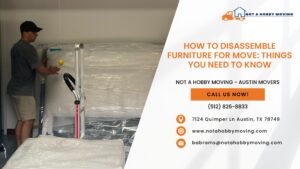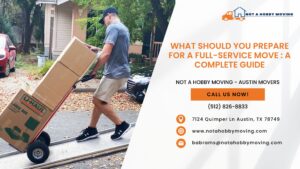When it comes time to move, anybody can just throw their stuff together haphazardly and call it a day. If you want your packing to get done right, though, you need to put in some more effort. As long as you follow this guide on how to pack moving boxes more effectively, you shouldn’t have any issues during your upcoming move.
Best Way To Pack Boxes For Moving
Use the Correct Supplies
Most people use boxes and bags that they already have lying around the house when they start packing. While this does save a bit of money, the end product won’t be pretty. Their stacks are going to be uneven and some of them will be difficult to carry.
If you buy boxes specifically made for moving, they’ll be much sturdier and come in only a handful of sizes, making stacking much more manageable. While you’re out, be sure to grab plenty of bubble wrap and tape. That way, you can wrap up breakables and secure all of the boxes once they’re full.
Sort Your Stuff Into Groups
Before you start throwing your things into boxes, you should split them up into categories. This will make both packing and unpacking easier. Nothing is worse than getting to your new place and not knowing where your pizza cutter is since you didn’t pack it with the rest of your kitchen stuff.
Be Strategic With Your Packing
Once you’re done categorizing, it’s time to start packing. You should begin by wrapping all of your fragile things in bubble wrap. Once they’re all covered, put them all into the same couple of boxes. Just be sure not to have them right up against each other. Either use towels or box dividers to give them an extra level of protection.
After that’s settled, it’s time to pack up everything else. It’s best to think of each box like a game of Tetris. You have to maneuver the pieces in just the right way to get them to fit securely and save as much space as you can. Try your best to fill each box to the brim. This will make stacking them much easier.
Never Pack Alone
No matter how closely you follow our guide on how to pack moving boxes more effectively, none of these will lead you to max efficiency if you’re working alone. You need to invite some friends or family members over to help you out.
If you don’t have any nearby or you’d rather have some pros help you out, then you’ll want to look into a packing and unpacking service like the one we offer. We’ll handle everything for you. That way, you can focus on more essential aspects of your move.
Where to Get Boxes for Moving
You may be able to find boxes for moving at retail or grocery stores but they likely won’t be very sturdy or in good condition to pack your stuff. Boxes from the grocery store can sometimes be wet and might collapse or damage your items. It may be difficult to find the right sizes of boxes too because you will be limited to whatever you can scrounge up. If your boxes are the same size they can be easily stacked and easier for movers to put on a dolly or carry. This will make your move go faster.
You don’t have to worry about finding boxes if you hire our professional movers who have the training and know-how to pack boxes for moving safely and efficiently. At Not A Hobby Moving we offer both packing and unpacking services and we have all the supplies needed to pack correctly like boxes, bubble wrap, dish packs, tape, packing paper, and any additional needed supplies. If you are moving in a hurry, our packing service will save you time.
Other Packing Materials to Have on Hand
In addition to boxes, several other supplies are commonly needed to pack for your residential move. Here are some essential packing supplies you may need:
- Packing Tape
- Bubble Wrap or Packing Paper
- Protective Wrapping like furniture blankets or moving pads or shrink wrap
- Packing Peanuts or Foam Inserts
- Marking Pens and Adhesive Labels
- Box Cutters or Scissors
- Furniture Straps and Moving Dollies
It’s important to assess your specific packing needs and acquire the appropriate supplies to ensure a smooth and efficient packing process while keeping your belongings protected during the move. All of these supplies can add to your moving costs if you buy them separately.
Fill the Moving Box Entirely
Overall, filling your moving boxes entirely ensures efficient use of space, prevents box collapse, protects your belongings, and makes for easier handling and stacking during the move. We recommend choosing appropriate box sizes and using bubble wrap or packing paper to fill any empty spaces and provide cushioning for fragile items.
Put Heavy Items in Small Moving Boxes
To pack a moving box with heavy items, put them into small moving boxes. This distributes weight evenly, prevents boxes from becoming too heavy, and ensures balance during stacking and transport. Small boxes are designed to handle less weight, protecting both items and handlers. They offer easier maneuverability and stability, reducing the risk of strain or mishandling. Plus, they optimize space by filling gaps with lighter items.
Put Light Items in Large Moving Boxes
Choose large moving boxes for packing light items. Large moving boxes maximize space and reduce the number of boxes needed. Light items are easier to handle and lift in larger boxes, minimizing strain and potential injuries. Large boxes provide room for proper cushioning and protection of your belongings, preventing shifting, bumping, and damage during transit. They facilitate organization and categorization, making it easier to locate and unpack items at your destination.
What Happens if I Don’t Fill the Box Entirely?
When you don’t fill a box up entirely, the contents of the box can shift when it’s moved and items can get broken or damaged. Filling a box up completely ensures you are using space efficiently and protects your belongings.
Take Extra Care When Wrapping Breakables
If you need to know how to pack a moving box with fragile items, use strong boxes and surround them with bubble wrap to provide added protection. Make sure to fill the box entirely with either packing paper or bubble wrap so your breakable items don’t move around in transit. Label the boxes as fragile and with the contents. If your breakables are valuable too then its best to carry them along with you
Use Box Dividers for Small Breakable Items
If you are packing breakable items, you can use box dividers in between them so your items are separated and don’t get broken. This will also keep them organized and allow for more efficient use of space when packing. Make sure the dividers fit snugly within your box and provide adequate protection for what you are packing.
What Shouldn’t Go in Boxes When Moving?
When packing to move, there are certain items that should not go in boxes due to safety, legal, or practical reasons.
Avoid packing hazardous materials, such as flammable, corrosive, or explosive substances. These include gasoline, propane tanks, chemicals, paint, pesticides, and cleaning agents. These items can pose a risk during transportation and are typically not allowed by moving companies or storage facilities due to safety regulations.
Do not pack perishable food items, especially those that require refrigeration. Perishable food can spoil quickly during transportation, leading to unpleasant odors, leaks, and potential health hazards. Instead, consume or donate perishable food items before the move.
Don’t pack living organisms, such as plants or pets, in boxes. Plants require proper care and ventilation, while pets require a safe and comfortable environment. Make separate arrangements for transporting plants or pets, ensuring their well-being throughout the moving process.
All valuable items, important documents such as passports, identification papers, and sentimental possessions like jewelry should be kept with you, rather than packing them in boxes. Carry these items personally or store them securely in a separate bag or container during the move so they will be safe with you.
Medications that require special handling or temperature control should be kept with you during the move. Avoid packing them in boxes to ensure accessibility and proper storage.
Keep personal essentials like clothing, toiletries, important electronics, and important daily-use items separate from packed boxes. These items should be readily accessible for immediate use upon arrival at the new location.
Seal and Label Each Box
Sealing and labeling each box when packing to move ensures the protection of your belongings, makes it easier to find your items when unpacking, and provides clear instructions for special handling of fragile items.








